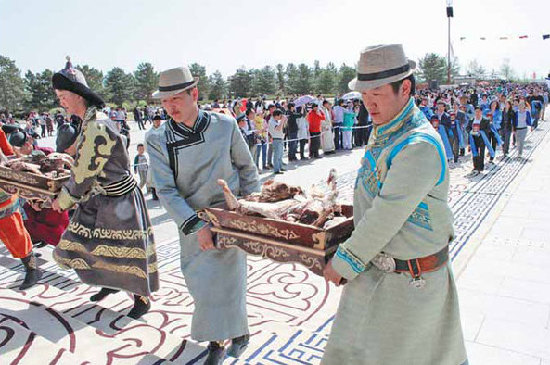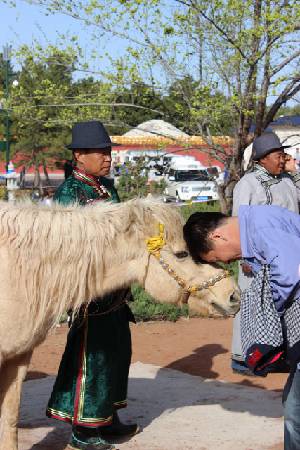The Darhad has scrupulously kept an oil lamp in the palace burning uninterruptedly for nearly 800 years as part of their sacred duties.
About 6,000 Darhad people now live in Ejin Horo, which translates to "courtyard of the Emperor Lord". More than 30 still perform full-time duties guarding the place and hosting dozens of rituals every year, among which Tsagaansurek is the biggest.
The complicated process of rituals has stayed unchanged through centuries and is among the first list of national intangible cultural heritage created in 2006.
Darhad men still sing a long ballad using an unidentified ancient language during the major rituals accompanied by a horse-head sacrificial instrument called the charig. The ballad is commonly called "the song of heaven" but no one knows its origin.
Even Khasbileg and his father, the only two men in the mausoleum who are able to read the characters, do not know their meaning. They are also reticent and reluctant to say much about this strange rite.
Khasbileg's father claims he cannot speak Mandarin, and his 16-year-old son, who looks energetic on the basketball court outside, suddenly falls silent during the interview.
They are from a family with one of highest positions among Darhad people. Since only men can be priests, Khasbileg has felt blessed to have a son.
 People offer sacrifices at the annual spring event Tsagaansurek at the Mausoleum of Genghis Khan
People offer sacrifices at the annual spring event Tsagaansurek at the Mausoleum of Genghis Khan
Most of the priests appear mysterious and keep solemn faces before the pilgrims, but Erdenesunver, a 38th-generation Darhad, is uncommonly approachable.
"Each family has its own duty covering certain part of the rituals," the 61-year-old retired priest says. "Each has some unique techniques, like singing the song of heaven.
"Our family's duty is to care for the main palace," he continues, although he stops at revealing more details.
According to Erdenesunver, there were 500 families safeguarding the mausoleum when Kublai Khan (1215-94) established eight white yurt palaces and launched the seasonal rituals.
The eight yurts had remained until 1939, when the mausoleum was moved westward to escape possible Japanese invasion. The mausoleum was moved back in 1954 and the current palace, where the yurts are gathered together, was built two years later.
He says there is no written record of the rituals but the rites are passed on through word of mouth, generation to generation. A golden book recording ancient shamanistic odes and anthems, which are sung during the rituals, had been well-preserved until it was lost in the 1960s.
Erdenesunver spent 15 years rummaging among historical files and priests' memoirs before he finally resurrected it in 2007. Public sacrifices gathering representatives from all banners in Ordos during Lunar New Year and Tsagaansurek have also been recovered in recent years, after the tradition was abandoned for decades.
"It is good to see the Darhad has attracted public interest in the traditions again after so long," he says. "I am overjoyed to see visitors from overseas."
 A man pray in front of the sacred horse
A man pray in front of the sacred horse
However, he also regrets that the Darhad phalange guarding the mausoleum has been shrinking, eroded by the desire to look for better opportunities in the big cities.
